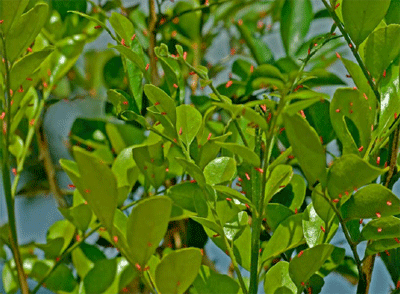Moving distance a day of the released citrus psyllid, Diaphorina citri using a newly developed marking method
Description
The Asian citrus psyllid, Diaphorina citri Kuwayama, is a vector of Asian Citrus Greening Disease which is spreading in Asia, including Japan, North and South America. Citrus greening disease or Huanglongbing (HLB) is the most destructive disease affecting citrus production. However, although knowledge of its vector ecology, especially dispersal studies, is needed for its control, data regarding the movement of this psyllid is minimal or entirely lacking. We have recently developed an effective marking method for this psyllid using fluorescent powder. We investigated the moving ability of the psyllids using this newly developed marking method and took into account moving characteristics as related to weather factors in the field.
First, we prepared 20,000 marked psyllids (Fig. 1) in a release experiment, reared for mass propagation in a glasshouse on orange jasmine. The reared psyllids used in this experiment were CG-free, since the CG bacterium does not propagate in orange jasmine. These marked psyllids were monitored at 65 points which comprised four orange jasmine trees per point, located concentrically at 50-m intervals up to 350 m from the release point (the center of our station) after one day (Fig. 2). Release experiments were conducted twice, in May and October 2005, at our station on Ishigaki Island, southwest of Japan.
The first experiment was conducted on March 21, 2005. The daily mean wind speed and daily mean wind direction at our station were 2.2 m/s and SSW, respectively, on the day of release. One day later, 516 psyllids had taken up residence on the orange jasmine plants at the monitoring points. Of those, 79.5% were observed on the north side and on the leeward of the release point. (Fig. 2).
The second experiment was conducted on October 15, 2005. The daily mean wind speed and daily mean wind direction at our station were 5.8 m/s and NNE, respectively, on the day of release. One day later, 118 psyllids were observed on the orange jasmine plants at the monitoring points. Of these, 96.6% were observed on the south side, on the leeward of the release point. The maximal distance traveled after a day of these marked psyllids was measured as 200 m and the mean moving distance was estimated at 66.9 m.
These results indicate that the marked vector psyllids moved to the leeward of the release point, and the maximal distance traveled after a day of these marked psyllids was measured as 350 m. The mean distance traveled in the two field experiments was estimated at 73.4 m. Since the psyllids moved 350 m in the first release experiment, some may have father migrated to the leeward side, exceeding the monitoring limit. These results will contribute to basic knowledge of the control strategy of this insect.
Figure, table
-
Fig. 1. Large amount of marked psyllids on orange jasmine for release experiments. -
Fig. 2. The movement of marked psyllids in a day from a release point.20,000 marked psyllids were released in the field on March 21, 2005, and a day later the number of psyllids was monitored visually on the orange jasmines. The intervals of the concentric circle were 50 m and the maximum range was up to 350 m.
- Affiliation
-
Japan International Research Center for Agricultural Sciences Okinawa Subtropical Station
- Classification
-
Technical A
- Term of research
-
FY2005(FY2002~2008)
- Responsible researcher
-
NAKATA Tadafumi ( Okinawa Subtropical Station )
- ほか
- Publication, etc.
-
Nakata T. :Effective Marking Method using Micronized Fluorescent Powder for Population and Dispersal Studies of the Citrus Psyllid, Diaphorina citri. Japanese Society of Applied Entomology and Zoology (in press)
Nakata T. (2006): [Abstract of 50th annual meeting of the Japanese Society of Applied Entomology and Zoology] (in press)
- Japanese PDF
-
2005_seikajouhou_A4_ja_Part20.pdf685.83 KB


